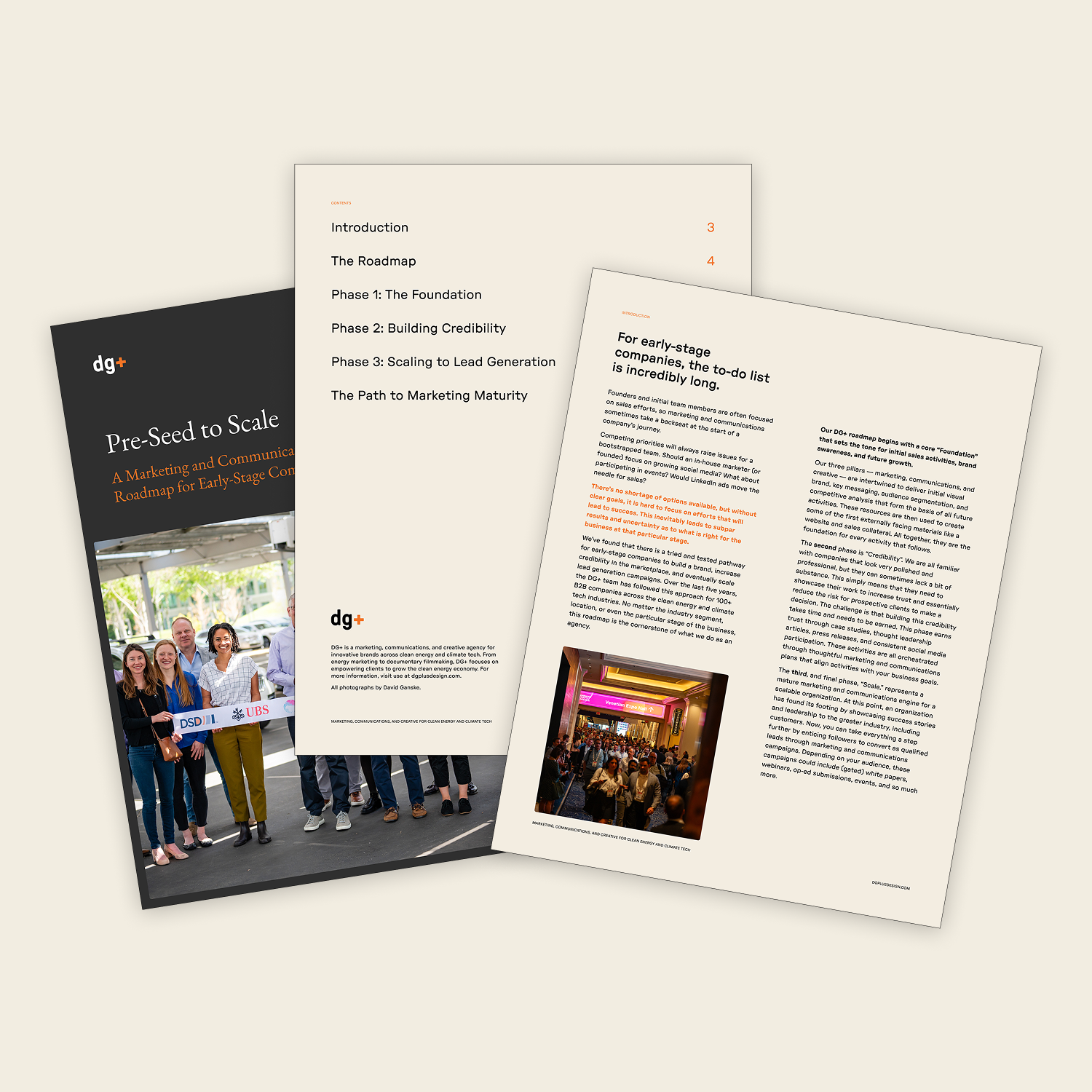2023 is finally here and we are thrilled about the lineup of clean energy and sustainability events slated for the new year. In this article, we offer a calendar view of 10+ cleantech events plus a deeper dive into some of the events that we are most excited to attend. If you are planning to attend any of the events, please reach out to us. We’d love to connect!
CES 2023
Las Vegas, Nevada
January 5 - 8, 2023
Technology
About CES 2023
CES® is the most influential tech event in the world — the proving ground for breakthrough technologies and global innovators. This is where the world's biggest brands do business and meet new partners, and the sharpest innovators hit the stage.
Why DG+ is excited about CES 2023
What isn’t compelling about exploring 2400+ innovative tech exhibits of all shapes and sizes? The organizers aren’t kidding when they say CES features every aspect of the tech sector. Naturally, some of the categories we are most excited about include energy/power, smart cities, sustainability, and vehicle technology. It will be invigorating to be surrounded by so many tech companies that are determined to become part of the climate solution(s).
In addition to an inspiring exhibit hall floor, CES also has an incredible speaker lineup that includes the likes of Carlos Tavares (Stellantis), Benson Chan (Strategy of Things), Mitch Klein (Silicon Labs), and Amira Aly (Lucid Motors).
At DG+ we value ambition, innovation, optimization, and efficiency, and CES checks all the boxes.
The Washington, DC Auto Show
Washington, DC
January 20 - 29, 2023
Electric Vehicles
About the DC Auto Show
The Washington, DC Auto Show® is held each January at the Walter E. Washington Convention Center and is the largest annual indoor public event in the District of Columbia. For more than 80 years, the auto show has modified its programming to accommodate the latest advances and trends in car technology. The 2022 Auto Show highlighted mobility advancements in all forms of transportation, including vehicle electrification. The 2023 show is expected to have an even more expansive display of battery-powered vehicles, sustainable buses, and new forms of all-electric mobility.
Why DG+ is excited about the DC Auto Show
This combines two of our CEO David Ganske’s favorite things in the world: 1) our nation’s capital, and 2) cars. Put those things together for almost 10 days to kick off the new year and it is a dream come true for DG.
The 2023 show will again feature the EV Pavilion, which was introduced to the event last year in an effort to cater to the growing electric mobility market and its high-hitting demand. Visitors will get a sneak peek at what the future of mobility looks like while browsing the latest electric models. There will also be an outdoor EV ride n’ drive event where attendees can test drive an all-electric vehicle on the streets of Washington DC!
DISTRIBUTECH
San Diego, California
February 7 - 9, 2023
Utilities
About DISTRIBUTECH
DISTRIBUTECH International® is the leading annual transmission and distribution event that addresses technologies used to move electricity from the power plant through the transmission and distribution systems to the meter and inside the home or business. The conference and exhibition offer education, information, products, and services related to electricity delivery automation and control systems, energy efficiency, demand response, distributed energy resource management systems, renewable energy and EVSE interconnection, advanced metering, T&D system operation, resiliency and reliability, communications technologies, cybersecurity, sustainability, and more.
Why DG+ is excited about DISTRIBUTECH
DISTRIBUTECH truly taps into our “nerdy-learning” core value here at DG+. The 2023 event looks unreal: 13 hand-selected, timely tracks that all speak directly to energy wonk hearts.
In last year’s version of this piece (Top Cleantech Events You Should Attend in 2022) I broke down which track each of my colleagues would likely pick if we were to attend DISTRIBUTECH as a team. With some new tracks and some new colleagues, I thought it would be fun to do that again.
- Kathleen is the colleague I’ve known the longest so this one was too easy: she’d opt for the DER for Flexibility and Resilience track. “Energy storage.” “Load handling.” “Microgrid integration.” “Planning.” These words are literal music to her ears.
- Melissa was a pretty easy mark as well: the Cyber and Physical Security track is right up her alley. Melissa is on constant alert for emerging threats and has sent me more articles about the importance of strong passwords than anyone I’ve worked with ever.
- Gavin was also easy to read because he’s a car guy, so the Electric Vehicles track would be his obvious choice. Though as a Chicagoan who believes smarter cities make for better places for people to live, the Smart Cities track would be a close runner-up.
- Now, I really thought Mel would be a shoo-in for Data Analytics. But then again, he’d probably already know a lot of what would be discussed, so it would have to be something else – Grid Modernization: real-time data applied for optimal utility situational awareness.
- Barbara was trickier than expected because her insatiable curiosity drives her to learn everything about everything. But the more I considered her passion for people and the planet the more Resiliency stood out: exploring how to deliver safe, reliable services to consumers in a rapidly changing landscape.
- For aesthetically oriented Mary, I think the Data Analytics track would be the right call because she really has a knack for making large amounts of data digestible through beautiful design.
- David’s choice would be…almost impossible to guess because he would literally be wringing his hands that he can’t attend them all. But if he had to choose, my money would be on the Utility Business Models and the New Energy Provider track, which explores future business models that will help utilities mitigate the energy transition.
- As for me, I’d be in full networking mode. I’d be popping in and out of our clients’ booths in the exhibit hall taking pictures of the ones designed by the DG+ team. I’d hit up the EV Zone to learn more about how utilities can better serve the private sector as EV adoption increases, and you know I’d be at every event with food and beverages (hello Cantina Receptions and Powered by Diversity Luncheon).
GreenBiz 23
Scottsdale, Arizona
February 14 - 16, 2023
Sustainability
About GreenBiz 23
GreenBiz is the premier annual event for sustainable business leaders. Today's sustainability professional is under pressure to do more, and do it faster, than ever before. GreenBiz 23 will bring together more than 1,600 sustainable business leaders to harness the knowledge of experts, peers, and new voices to help achieve net zero, advance the circular economy, elevate social justice, safeguard biodiversity, build resilient supply chains, and more.
Why DG+ is excited about GreenBiz 23
We expect GreenBiz 23 to be three incredible days chock-full of inspiring keynote speeches from the likes of Cynthia Muffuh (UN Global Compact) and Patrick Flynn (Salesforce) and informative breakout sessions. The six thematic tracks are Circular Value Chains, Engaging Your Audience, Finance & ESG, Leading Change, Net Zero Everything, and Supply Chain Resilience.
This event is known for fostering a deep sense of community among like-minded attendees who share an enthusiasm and passion for sustainability.
Solar + Wind Finance & Investment Summit
Phoenix, Arizona
March 13 - 15, 2023
Finance
About Solar + Wind Finance & Investment Summit
Infocast’s unified Solar + Wind Finance & Investment Summit in 2022 gathered an unprecedented number of leading industry players to network, make deals, and get fully briefed on the renewables markets. This exceptional event is back March 13-15, 2023.
Why DG+ is excited about the Solar + Wind Finance & Investment Summit
The passage of the Inflation Reduction Act (IRA), which has brought about supercharged tax credits and long-term policy certainty, makes this year’s event extra intriguing. Anyone paying the slightest bit of attention knows that the future is brighter than ever for renewable energy investment, but capitalizing on these novel opportunities requires a keen understanding of how to navigate these waters. This event boasts an impressive line-up of featured speakers from the likes of EDF Renewables, NovoHydrogen, Standard Solar, Bank of America, and more who will give attendees the inside scoop on how to take maximum advantage of this new investment landscape.
BNEF Summit
New York, New York
April 24 - 25, 2023
Renewable Energy
About the BNEF Summit
The BNEF Summit provides the ideas, insights and connections to formulate successful strategies, capitalize on technological change and shape a cleaner, more competitive future.
Why DG+ is excited about the BNEF Summit
The 2023 BNEF agenda is still being shaped, but based on last year’s event we expect there will be a lot to look forward to. Tracks included ESG & Sustainable Finance, Energy Infrastructure Investment, and Trade & Industry. The 2022 speaker list was very impressive and included representatives from Boundary Stone Partners, the US Department of Energy, Goldman Sachs, Google, BloombergNEF (naturally), and many more.
CLEANPOWER 2023
New Orleans, Louisiana
May 22-25, 2023
Renewable Energy
About CLEANPOWER
CLEANPOWER unites the most knowledgeable minds in the clean energy industry and creates a platform for professionals to discuss the latest industry challenges and opportunities.
Why DG+ is excited about CLEANPOWER
The conference does more than just bring together the different technologies that make up the renewables mix: wind, solar, storage, and transmission. It also unites the various segments within those industries: manufacturers, construction firms, owner-operators, utilities, financial firms, corporate buyers, and more.
And while the feature speaker list for 2023 has yet to be released, the 2022 lineup had some heavy hitters including U.S. Department of Energy Jennifer Granholm and Senator Ron Wyden (D-OR) Chairman, Senate Committee on Finance.
GreenFin
Boston, Massachusetts
June 26 - 28
Finance
About GreenFin 23
GreenFin 23 will convene an influential audience of finance, investment, and sustainability professionals to share insights, address key challenges, and showcase leading sustainable financial products and services.
Why DG+ is excited about GreenFin 2023
We’ve said it before and we’ll say it again: this is an electrifying time for sustainable finance and investing. The climate crisis requires substantial changes to the foundations of our economy, and ESG analysis and investing have the potential to shift capital markets toward sustainable outcomes. GreenFin 2023 will bring together investors, asset owners / managers, and forward-thinking companies in order to align corporate and institutional finance with the goals of a clean and just economy.
The details of the 2023 event are still being finalized, but past speakers from industry leaders such as Salesforce, Robinhood, Blackstone, As You Sow, and Morningstar give us high hopes for a stellar 2023 lineup.
Electrify Expo
Long Beach, California
June 3 - 5, 2023
Electric Vehicles
About the Electrify Expo
Electrify Expo is North America's largest electric vehicle festival filled with over 1 million square feet of the world's top electric mobility brands. Drive electric vehicles, ride e-bikes, e-motorcycles, e-scooters, e-skateboards + learn what the future of mobility looks like.
Why DG+ is excited for Electrify Expo
The future of mobility is electric, and that includes vehicles of all shapes and sizes. While the entire DG+ team has now been behind the wheel of an electric car (thanks for the Fremont factory tour, Tesla!) we haven’t all ridden an e-skateboard. And because Electrify Expo actually has seven events in North America in 2023, the whole dispersed DG+ just might get a chance to!
It turns out peak summer isn’t a prime time for cleantech and sustainability events. Perhaps organizers are nudging you to finally take that vacation you’ve been dreaming about. If you work in this industry that means you are actively trying to preserve this incredible planet – so please, go enjoy it.
RE+
Las Vegas, Nevada
September 11 - 14, 2023
Solar
About RE+
Hosted by the Solar Energy Industries Association (SEIA) and the Smart Electric Power Alliance (SEPA), RE+ 2023 will be the largest gathering of solar, smart energy, energy storage, and hydrogen fuel cell professionals in North America and offers a unique opportunity for the entire renewable energy industry to collaborate and grow business. Attendees represent all segments of the industry, from installers, manufacturers, developers, utilities, C&I, and more.
Why DG+ is excited about RE+
For starters, we had a blast at RE+ 2022 in Anaheim and we can’t wait to do it again in Vegas. We enjoyed tons of great presentations and panels (one of which featured our very own David Ganske), we walked the showroom floor until we had blisters, we happy hour-ed with clients, we saw a selection of EVs including buses and the new Hummer EV Pickup, and we even got to see some of our own work come to life in the form of client booths and presentations.
The details of this year’s event are still being fleshed out, but based on our experience at the 2022 event we are sure RE+ 2023 is going to be amazing.
LA Auto Show
Los Angeles, California
November 18 - 27, 2023
Electric Vehicles
About the LA Auto Show
Founded in 1907, the Los Angeles Auto Show (LA Auto Show®), is one of the most influential and best-attended auto shows globally and spans more than 1,000,000 square feet. Each fall, show creator ANSA Productions gathers the who’s who of the auto industry to unveil the future of mobility in the car culture capital of the world.
Why DG+ is excited about the LA Auto Show
If you’ve read the rest of this article you’ve likely picked up on the fact that our CEO and founder David Ganske is a huge car guy. And because the LA Car Show is basically in his backyard, it is very safe to bet that you will find him here. (Check out his pictures from last year’s event.)
This show focuses on the future of mobility, which – in case you hadn’t heard – is electric. EVs are not only good for the environment, they are also great for automakers because they are easier to manufacture than internal combustion engine (ICE) vehicles, plus they are great for drivers because they are easier (and cheaper) to maintain.
It is no surprise that the growing trend of vehicle electrification took center stage at the 2022 show, and we can’t wait to see even more new models in 2023.
COP 28
United Arab Emirates
November 30 - December 12, 2023
Sustainability
About COP 28
The 28th session of the Conference of the Parties (COP 28) to the UNFCCC (United Nations Climate Change Conference) will take place in the United Arab Emirates. The summit aims to address some of the vital issues surrounding climate change.
Why DG+ is excited about COP 28
Every COP is an occasion to look forward to as the entire purpose of these summits is to solve some of the most pressing climate issues. The 2023 event will similarly carry a lot of environmental expectations and hopefully result in some major resolutions to combat climate change. COP 28’s significance is especially elevated due to where it is being held: the United Arab Emirates (UAE).
The UAE is one of the world’s biggest oil exporters. Roughly 30% of the country’s GDP comes from oil and gas, and many of its other major industries, including construction and travel, are financially tied to fossil fuels. As most climate-conscious people know, the burning of fossil fuels generates greenhouse gases (GHGs), and GHGs are a major driver of climate change.
While the UAE has laid out a number of “green” initiatives in recent years, the irony of a leading global oil exporter hosting the world’s largest summit addressing climate change is, let’s just say, not something to be ignored.
Matthew Hedges, an expert on the UAE’s political economy, astutely describes this potential conflict of interests:
“The Emirates is a country with some of the world’s largest oil reserves, with a desire to continue to expand and enhance fossil fuel production. There will be an effort to illustrate their engagement in renewables, particularly solar and nuclear, but there are questions to be asked about how you can engage in such conflicting actions.”
Mark Your Calendar
There are so many awesome clean energy and sustainability events coming up this year that I admit I got a little carried away (I ditched the idea of a “Top 5” list midway through my February research). Even so, there are plenty that I didn’t get to cover above so please see the much more user-friendly chart below to plan your 2023 cleantech event calendar. Oh, and make sure to let us know what events you’ll be attending so we can hopefully meet up!
Dates |
Event |
Location |
Topics |
| January 5 - 8 |
CES 2023 |
Las Vegas, Nevada |
Technology, Energy/Power, Smart Cities, Sustainability, Vehicle Technology |
| January 18 - 19 |
Community Solar Power Summit |
San Diego, California |
Community Solar, Solar |
| January 20 -29 |
DC Auto Show |
Washington, DC |
Electric Vehicles |
| January 24 - 26 |
Projects and Money |
New Orleans, Louisiana |
Finance |
| February 7 - 9 |
DISTRIBUTECH |
San Diego, California |
Utilities, Electric Vehicles, Smart Cities, Data Analytics |
| February 11 - 20 |
Chicago Auto Show |
Chicago, Illinois |
Electric Vehicles |
| February 14 - 16 |
GreenBiz 23 |
Scottsdale, Arizona |
Sustainability, Circular Economy, ESG, Finance |
| February 14 - 16 |
Intersolar North America |
Long Beach, California |
Solar, Solar + Storage, EV Charging, Green Hydrogen |
| March 5 - 8 |
TechAdvantage |
Nashville, Tennessee |
Technology, Energy Services, Electric Cooperative |
| March 13 - 15 |
Solar + Wind Finance & Investment Summit |
Phoenix, Arizona |
Finance, Investment, Renewables |
| March 20 - 21 |
SEIA’s Finance, Tax & Buyers Seminar |
New York City, New York |
Finance, Business, Clean Energy |
| April 24 - 25 |
BNEF Summit |
New York City, New York |
Renewable Energy, ESG, Sustainable Finance |
| May 22 - 25 |
CLEANPOWER 2023 |
New Orleans, Louisiana |
Renewable Energy, Utilities, Wind, Solar, Storage, Finance |
| May 23 - 25 |
Electric & Hybrid Vehicle Technology Expo |
Stuttgart, Germany |
Electric Vehicles, Hybrid Vehicles, Technology |
| June 3 - 5 |
Electrify Expo |
Long Beach, California |
Vehicle Electrification |
| June 5 - 7 |
Circularity |
Seattle, Washington |
Circular Economy |
| June 26 - 28 |
GreenFin |
Boston, Massachusetts |
Finance, ESG |
| September 11 - 14 |
RE+ |
Las Vegas, Nevada |
Clean Energy, Solar Energy, Wind Energy, Energy Storage, Microgrids, Electric Vehicles, Hydrogen, Fuel Cells |
| October 16 - 19 |
Sustainable Brands |
San Diego, California |
Sustainability |
| October 24 - 26 |
VERGE 2023 |
San Jose, California |
Climate Tech |
| November 12 - 15 |
NARUC’s 2023 Annual Meeting and Education Conference |
La Quinta, California |
Utilities |
| November 18 - 27 |
LA Auto Show |
Los Angeles, California |
Electric Vehicles, |
| November 30 - December 12 |
COP 28 |
United Arab Emeriates |
Sustainability |


















.avif)








